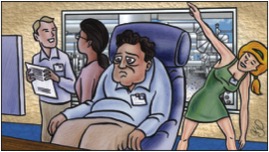“Back to my Mac.” Wang stretched. “No matter how ergonomic the setup is, I still leave with a sore back from sitting incorrectly, burning wrists from all the typing, and tired eyes from peering at a computer screen. Man was not meant to work a desk job.” Excerpt from “Blindman’s Bluff” by Faye Kellerman.
I am diseased, but do not have to go to the doctor and have medical tests performed in order to know that I have sitting disease. I am not the only person. According to a 2008 Vanderbilt University study of 6,300 people published in the American Journal of Epidemiology, the average American spends 55% of waking time (7.7 hours per day) in sedentary behaviors such as sitting. I am above average.
This week I sat in cars, on planes, in restaurants, and in hotel rooms. I sat in meetings with one client in Houston this week for about seven hours for three days, with another client in Atlanta for about eight hours, and today at home watching television and working with a computer in my lap (multitasking) for eight hours. My sitting time was at least 12 hours per day.
How much time do you sit each day? Do you have sitting disease?
Sitting disease is a term used to describe sitting too long or too much. The term captures how many people sit for hours in front of the TV, in cars and at the office. Sitting disease has been linked to increased risks ofType 2 diabetes, cognitive decline, disability in people over 60, and death from cancer, heart disease and stroke.
If you want to learn more about the risks of sitting disease and steps to address it, read Get Up! Why Your Chair Is Killing You and What You Can Do About It by James A. Levine. His advice is simple: Get up, get moving, keep moving, and stay active. It is simple to say, more difficult to do given the sedentary nature of most jobs today.
Satchel Paige was a baseball pitcher. I recalled he said, “Never run when you can walk, never walk when you can stand, never stand when you can sit, and never sit when you can lie down.” The opposite is true today. If you can stand, don’t sit. If you can walk, don’t stand.
One should stand up 10 minutes of each hour and walk around the office or work area several times during a work period. If your company provides sit-stand desks, take advantage of the opportunity to stand to combat both sitting disease and to increase alertness. 67% of American workers wish their employers provided them desks that provided them the option to work either standing or sitting, according to one study.
If you would like more information including an Info Graphic, look at http://www.juststand.org. You can also Google “sitting disease” if this month’s article is not convincing about the risks of too much sitting.
Set a goal to stand up more at work and at home. If you have to sit, learn some stretches and exercise that can be done at your desk. Let’s resolve to conquer sitting disease in pipeline control rooms and increase our well being. Rise up!




